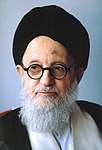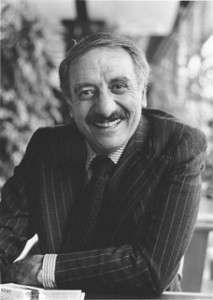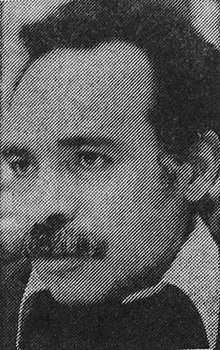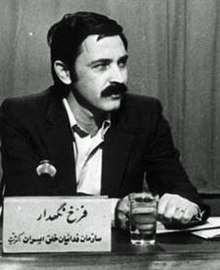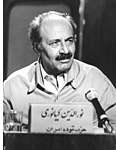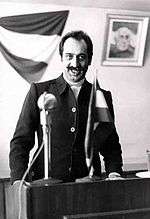1979 Iranian Constitutional Convention election
Constitutional Convention elections were held in Iran on 3 and 4 August 1979. The result was a victory for the Islamic Republican Party.[3] 10,784,932 voted in the elections, marking 51.71% turnout.[2] Of all members elected, 68% were clerics.[4]
| |||||||||||||||||||||||||||||||||||||||||||||||||||||||||||||||||||||
All 73 seats to the Assembly of Experts for Constitution | |||||||||||||||||||||||||||||||||||||||||||||||||||||||||||||||||||||
|---|---|---|---|---|---|---|---|---|---|---|---|---|---|---|---|---|---|---|---|---|---|---|---|---|---|---|---|---|---|---|---|---|---|---|---|---|---|---|---|---|---|---|---|---|---|---|---|---|---|---|---|---|---|---|---|---|---|---|---|---|---|---|---|---|---|---|---|---|---|
| Registered | 20,857,391[2] | ||||||||||||||||||||||||||||||||||||||||||||||||||||||||||||||||||||
| Turnout | 51.71%[2] | ||||||||||||||||||||||||||||||||||||||||||||||||||||||||||||||||||||
| |||||||||||||||||||||||||||||||||||||||||||||||||||||||||||||||||||||
The new constitution drawn up by the body was approved by the voters in a referendum in December.[2]
Campaign
During the elections, Islamic Republican Party had the upper hand when many clerical organizations and friday prayer imams endorsed IRP candidates and the National Television gave them extra time. Their campaign literature featured large pictures of Ayatollah Khomeini, who urged the voters to elect candidates with "Islamic qualifications", on the grounds that only such candidates are able to draft a genuine Islamic constitution.[5]
Different leftist groups fielded candidates for the elections, including the Tudeh Party of Iran, the Organization of Iranian People's Fedai Guerrillas, the Organization of Struggle for the Emancipation of the Working Class and the Socialist Workers' Party of Iran. Among the nominees of the latter was the only soldier to run in the elections and two people in Khuzestan Province who campaigned while being jailed.[6]
People's Mujahedin of Iran ran 26 candidates under its banner, including Massoud Rajavi in Tehran, Mousa Khiabani, Ahmad Hanifnejad and two others in Azerbaijan, eleven in central provinces, six in the northern provinces of Caspian and four in Khorasan.[7]
Boycott
Several parties including National Front and National Democratic Front boycotted the elections in protest to the new press law, the result of which was to close many newspapers.[8] They also protested the election method, in which the voters should write names of the candidates on the ballot slips. They regarded it questionable, considering the high rate of illiteracy at the time.[9]
Pan-Iranist Party was also among the boycotting groups.[10]
Conduct
The elections were held nationwide, except for two constituencies in Kurdistan Province, where an insurgency was underway. The voting age was reduced to 16 before the elections to make more citizens eligible to vote.[1]
Results
- Abrahamian (1989)
According to Ervand Abrahamian, most of the winners were pro-Islamic Republican Party (IRP) candidates including 55 clerics (15 ranking ayatollah and 40 with the title of hujjat al-Islam) and 11 laymen. Others were four reserved seats for the representatives of the official religious minorities (Armenians, Assyrians, Jews and Zoroastrians), three Azerbaijani candidates endorsed by the Muslim People's Republican Party, one Democratic Party of Iranian Kurdistan member barred from taking his seat, three affiliated with the Freedom Movement of Iran (including one member and two sympathetics), plus Mahmoud Taleghani and Ali Golzadeh Ghafouri, who was close to him.[5]
- Nohlen et al (2001)
| Party | Seats | % |
|---|---|---|
| Islamic Republican Party | 55 | 75.3 |
| Freedom Movement | 6 | 8.2 |
| Muslim People's Republican Party | 4 | 5.5 |
| Minority reserved seats | 3 | 4.1 |
| Democratic Party of Iranian Kurdistan | 1[lower-alpha 1] | 1.4 |
| Total | 73 | 100 |
| Source[3] | ||
- Adib-Moghaddam (2014)
| List | Seats |
|---|---|
| Great Islamic Coalition | 58 |
| Freedom Movement | 8 |
| Muslim People's Republican Party | 7 |
| Total | 73 |
| Source[4] | |
References
- Credentials of Ghassemlou were rejected.[2]
- Zabir, Sepehr (2012). Iran Since the Revolution (RLE Iran D). Taylor & Francis. pp. 34–35. ISBN 1136833005.
- "The 1979 Assembly of Experts for the Drafting of the Constitution Election", The Iran Social Science Data Portal, Princeton University, archived from the original on 2015-09-24, retrieved 10 August 2015
- Nohlen, Dieter; Grotz, Florian; Hartmann, Christof (2001). "Iran". Elections in Asia: A Data Handbook. I. Oxford University Press. p. 74. ISBN 0-19-924958-X.
- Arshin Adib-Moghaddam (2014). A Critical Introduction to Khomeini. Cambridge University Press. p. 112. ISBN 978-1-107-72906-3.
- Ervand Abrahamian (1989), "The Islamic Republic", Radical Islam: the Iranian Mojahedin, Society and culture in the modern Middle East, 3, I.B.Tauris, pp. 54–55, ISBN 9781850430773
- Robert Jackson Alexander (1991), "Socialist Workers' Party — HKS", International Trotskyism, 1929-1985: A Documented Analysis of the Movement, Duke University Press, ISBN 082231066X
- Ervand Abrahamian (1989), "To The Masses", Radical Islam: the Iranian Mojahedin, Society and culture in the modern Middle East, 3, I.B.Tauris, p. 193, ISBN 9781850430773
- Axworthy, Michael (2016), Revolutionary Iran: A History of the Islamic Republic, Oxford University Press, p. 159, ISBN 9780190468965
- Menashri, Daṿid (1990), Iran: a decade of war and revolution, Holmes & Meier, p. 86, ISBN 9780841909496
- Nikazmerad, Nicholas M. (1980), "A Chronological Survey of the Iranian Revolution", Iranian Studies, 13 (1–4): 327–368, JSTOR 4310346
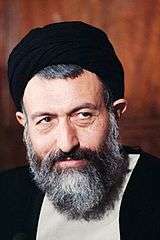
.jpg)
